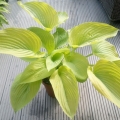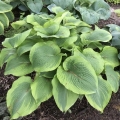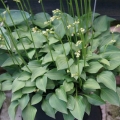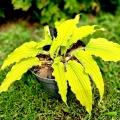Online Shop
130
Royal Horticultural Society
Gold Medals
Royal Horticultural Society
Gold Medals
- Home
- About Bowdens
- Paul Whittaker
- Taming the Dragon by John Ardell - The Gardener, September 1977
Taming the Dragon by John Ardell - The Gardener, September 1977
Paul Whittaker shares his experiences of cultivating bamboos in containers with Jon Ardle of the RHS magazine "The Garden"
Bamboos are one of the most evocative of garden plants; nothing conjures up the image of the orient as powerfully as the sight and sound of their graceful evergreen leaves and stems swaying in the breeze. They do, however, have an undeserved reputation for being something of a horticultural thug: perceived wisdom suggests introducing bamboo into a garden will soon result in the plant taking over, destroying everything in its path, before flowering and promptly dropping dead. This is unnecessarily alarmist. While there are tropical species capable of astonishing rates of growth with invasive runners, there are many smaller and slower growing species, which make excellent features for temperate gardens.
Many have beautifully marked culms (stems) and some have variegated leaves. Some of these are still capable of out growing their allotted space however, and it used to be thought growing containers was difficult, if not impossible. Nursery owner Paul Whittaker, of P W Plants, Norfolk, has shown this to be untrue: he grows even very large specimens up to 5m (16ft) tall in pots and maintains many species can be grown in this way provided that their specific cultural requirements are met.
Bamboo Morphology
Bamboos are part of the grass family, but unlike the other subfamilies, the 1,050 to 1,070 species of the Bambusoideae produce woody stems, which include deposits of silica. The silica makes bamboo culms one of the toughest of organic structures.
The growth habit of bamboo species depends upon their underground rhizomes. Clump forming or pachymorphic species have short, thick rhizomes which produce shoots only at their tips, which results in a tight stand of culms that expands fairly evenly around its circumference. Running or leptomorphic species have long, thin rhizomes extending over great distances which produce shoots along their whole lengths - the most invasive species belong to this group. A third group, the intermediates, have root systems showing aspects of both types. Leptomorphic species grown in cooler conditions than they are used to often have a more clumping habit.
Most bamboos flower very rarely - perhaps only once every 70 or 80 years - meaning they are not often grown from seed but are generally propagated by division, which can make them expensive.
Cultivation in containers
Bamboos can look superb when well grown in large pots, especially terracotta or glazed, oriental-style containers. Whatever the material, the container should be equipped with adequate drainage holes. Pot culture also has the advantage of raising the culms closer to eye level, giving the plant even more of an impact. In small gardens, where space is at a premium, bamboos can be grown in pots to restrict their spread, particularly the invasive, running types.
Choice of species
It is important to understand the potential size and growth habit of bamboo species when considering their suitability for pot culture. They are hungry plants and will not tolerate drought: lack of water can cause the leaves to turn brown and in severe cases produce near-complete loss of leaves, and recovery is slow. The more vigorous and invasive species will rapidly fill their containers with rhizomes and roots, lowering the water-holding capacity and exhausting the supply of nutrients. Paul has shown that it is possible to grow vigorous species in containers, at least temporarily, provided adequate irrigation and feeding are given. Such plants can require repotting annually, but he has also identified a number of species more suited to longer-term, near permanent pot culture.
Siting
This is an important consideration; a sheltered spot with as much wind protection as possible reduces the risk of excessive water loss, both in summer and in winter. Although fully hardy in the ground, a bamboo in a container can suffer from drought in winter. Its evergreen leaves can be stripped of water by cold winds and its root system is unable to replace the moisture from frozen compost. Insulating the pot with bubble wrap or covering the plant with fleece in very cold weather may be necessary, or plants can be moved into an unheated greenhouse. During mild spells in winter, it is important to check the compost regularly as watering may be required.
Compost
Paul recommends a peat-based compost in glazed pots because, although bamboos have a high demand for water, they will not tolerate waterlogging. His standard nursery mixture is 85 percent compost, 10 percent composted bark and 5 percent grit. Grit improves drainage and gives extra weight, helping pot stability. In a porous terracotta pot, soil-based John Innes composts can be used. Water storage granules and slow-release fertilisers can be added to the compost although regular liquid feeding is still recommended to keep plants looking their freshest.
Repotting
Repotting is one of the most critical aspects of the cultivation of bamboos in containers. Other than dwarf and very slow-growing species, most bamboos will fill their pots with roots within two years, and if not repotted the lack of available water and nutrients will cause the plant to deteriorate. The toughness of bamboo culms also extends to their rhizomes, and division is not for the faint-hearted. Tearing a clump apart is not only difficult, it can cause the plant extensive damage. If the root system is relatively open, secateurs may be used, however Paul has found sawing or chopping with an axe the least damaging method of dividing congested rootballs.
The aim of the repotting process is to rejuvenate the plant, by removing some of the root system and replacing it with fresh compost. The most vigorous, healthiest, part of the rootball is around the edge of running bamboos, and this can be replaced nearer the centre of the pot if the plant is also divided. At the same time the top growth is thinned.
Repotting procedure
Repotting is best carried out in autumn, as plants enter dormancy but while temperatures are still warm enough to allow some root growth; before culm growth begins in spring is the next best choice. Ideal weather conditions for the procedure are a cool, overcast day, without strong sunshine. Following division, the thinning of the top growth is an important stage. Removing old, thin and weak growth prevents the root system from becoming overtaxed by decreasing the demand for water from the culms. One-year-old shoots are left unpruned because these will branch next year, but it is possible to remove 30-50 percent of the top growth without harming the plant. Pruning in this way will concentrate growth into the new shoots which will come through thicker and stronger. Some dwarf species like Pleioblastus auricomus and P. variegatus can be sheared to ground level every spring, which results in the freshest looking new foliage being produced later in the season. With tall species, it is possible to reduce the height of the culms drastically without harming the plant, and encourage leafy side shoots to be produced lower down the stem.
Maintenance and presentation
Bamboos in containers must never dry out, and look their freshest when regular, balanced liquid feed is given. Little maintenance is required, other than the removal of dead leaves. Older canes can be thinned annually to tidy the plant, preferably in spring when their new leaves begin to appear. There is no reason why bamboos should not be underplanted with other species but in practice these need to be chosen carefully to blend in and must be able to withstand the competition. Ophiopogon planiscapus 'Nigrescens' contrasts beautifully with gold-stemmed species, and Paul has found Hedera helix 'Dragon's Claw' and Acorus gramineus also look good. Drawing on the oriental theme, a mulch of gravel or perhaps a few carefully chosen stones or pieces of driftwood can be used to give the finishing touches, however bear in mind it is the bamboo itself which is the star and which sets the theme - the chorus line should not detract from it.
Bamboos are available in a variety of sizes to suit every garden, and have a range of coloured culms and variegated leaves; most remain evergreen. The sigh of the wind through their graceful plumes of foliage and contribute greatly to the sights and sounds of a garden, as many countries in Europe have already discovered. Paul's experimentation has demonstrated that it is perfectly possible to maintain many species in a pot successfully. Some of the real 'dragons', which should not be roaming the average garden, can be tamed by restriction in a container, provided that the work involved in regular repotting is carried out. The smaller and slower growing members of the group can make excellent potted specimens, being no more difficult to maintain in pots than other groups of broadleaved evergreens, provided their watering and feeding regimes are adequate.
Bamboos can add a touch of evergreen exotica to any garden. However, be warned - their charms can prove subtly addictive, and the first plant will almost certainly be followed by another.
Bamboos for short–term pot culture
Plants in this category require division, planting out or replacing after 2-3 years in a pot. Quoted heights, in metres, are the normal maximum for garden specimens. Plants in pots are likely to be shorter. Rhizome or root types, which control the way a bamboo spreads, are as follows:
Pachymorphic (clumping) rhizomes
Leptomorphic (running) rhizomes
Intermediate (aspects of both)
Bamboos for long–term pot culture
Slower growing bamboos, and some running species, can be kept in a pot for up to six years. Division will rejuvenate the plant.
Pot selection
Bamboo species spread indefinitely so the size of pot will ultimately control the size of plant. It is important, however, to pot on in stages – a small plant in too large a pot will tend to be affected by water logging. Choice of pot should be dictated by the size of the plant on purchase and by its mature height. For example, a plant bought in a 3 litre (7-8 inch) pot can be potted into a 10 litre (10-12 inch) container if growing vigorously.
Bamboos are one of the most evocative of garden plants; nothing conjures up the image of the orient as powerfully as the sight and sound of their graceful evergreen leaves and stems swaying in the breeze. They do, however, have an undeserved reputation for being something of a horticultural thug: perceived wisdom suggests introducing bamboo into a garden will soon result in the plant taking over, destroying everything in its path, before flowering and promptly dropping dead. This is unnecessarily alarmist. While there are tropical species capable of astonishing rates of growth with invasive runners, there are many smaller and slower growing species, which make excellent features for temperate gardens.
Many have beautifully marked culms (stems) and some have variegated leaves. Some of these are still capable of out growing their allotted space however, and it used to be thought growing containers was difficult, if not impossible. Nursery owner Paul Whittaker, of P W Plants, Norfolk, has shown this to be untrue: he grows even very large specimens up to 5m (16ft) tall in pots and maintains many species can be grown in this way provided that their specific cultural requirements are met.
Bamboo Morphology
Bamboos are part of the grass family, but unlike the other subfamilies, the 1,050 to 1,070 species of the Bambusoideae produce woody stems, which include deposits of silica. The silica makes bamboo culms one of the toughest of organic structures.
The growth habit of bamboo species depends upon their underground rhizomes. Clump forming or pachymorphic species have short, thick rhizomes which produce shoots only at their tips, which results in a tight stand of culms that expands fairly evenly around its circumference. Running or leptomorphic species have long, thin rhizomes extending over great distances which produce shoots along their whole lengths - the most invasive species belong to this group. A third group, the intermediates, have root systems showing aspects of both types. Leptomorphic species grown in cooler conditions than they are used to often have a more clumping habit.
Most bamboos flower very rarely - perhaps only once every 70 or 80 years - meaning they are not often grown from seed but are generally propagated by division, which can make them expensive.
Cultivation in containers
Bamboos can look superb when well grown in large pots, especially terracotta or glazed, oriental-style containers. Whatever the material, the container should be equipped with adequate drainage holes. Pot culture also has the advantage of raising the culms closer to eye level, giving the plant even more of an impact. In small gardens, where space is at a premium, bamboos can be grown in pots to restrict their spread, particularly the invasive, running types.
Choice of species
It is important to understand the potential size and growth habit of bamboo species when considering their suitability for pot culture. They are hungry plants and will not tolerate drought: lack of water can cause the leaves to turn brown and in severe cases produce near-complete loss of leaves, and recovery is slow. The more vigorous and invasive species will rapidly fill their containers with rhizomes and roots, lowering the water-holding capacity and exhausting the supply of nutrients. Paul has shown that it is possible to grow vigorous species in containers, at least temporarily, provided adequate irrigation and feeding are given. Such plants can require repotting annually, but he has also identified a number of species more suited to longer-term, near permanent pot culture.
Siting
This is an important consideration; a sheltered spot with as much wind protection as possible reduces the risk of excessive water loss, both in summer and in winter. Although fully hardy in the ground, a bamboo in a container can suffer from drought in winter. Its evergreen leaves can be stripped of water by cold winds and its root system is unable to replace the moisture from frozen compost. Insulating the pot with bubble wrap or covering the plant with fleece in very cold weather may be necessary, or plants can be moved into an unheated greenhouse. During mild spells in winter, it is important to check the compost regularly as watering may be required.
Compost
Paul recommends a peat-based compost in glazed pots because, although bamboos have a high demand for water, they will not tolerate waterlogging. His standard nursery mixture is 85 percent compost, 10 percent composted bark and 5 percent grit. Grit improves drainage and gives extra weight, helping pot stability. In a porous terracotta pot, soil-based John Innes composts can be used. Water storage granules and slow-release fertilisers can be added to the compost although regular liquid feeding is still recommended to keep plants looking their freshest.
Repotting
Repotting is one of the most critical aspects of the cultivation of bamboos in containers. Other than dwarf and very slow-growing species, most bamboos will fill their pots with roots within two years, and if not repotted the lack of available water and nutrients will cause the plant to deteriorate. The toughness of bamboo culms also extends to their rhizomes, and division is not for the faint-hearted. Tearing a clump apart is not only difficult, it can cause the plant extensive damage. If the root system is relatively open, secateurs may be used, however Paul has found sawing or chopping with an axe the least damaging method of dividing congested rootballs.
The aim of the repotting process is to rejuvenate the plant, by removing some of the root system and replacing it with fresh compost. The most vigorous, healthiest, part of the rootball is around the edge of running bamboos, and this can be replaced nearer the centre of the pot if the plant is also divided. At the same time the top growth is thinned.
Repotting procedure
Repotting is best carried out in autumn, as plants enter dormancy but while temperatures are still warm enough to allow some root growth; before culm growth begins in spring is the next best choice. Ideal weather conditions for the procedure are a cool, overcast day, without strong sunshine. Following division, the thinning of the top growth is an important stage. Removing old, thin and weak growth prevents the root system from becoming overtaxed by decreasing the demand for water from the culms. One-year-old shoots are left unpruned because these will branch next year, but it is possible to remove 30-50 percent of the top growth without harming the plant. Pruning in this way will concentrate growth into the new shoots which will come through thicker and stronger. Some dwarf species like Pleioblastus auricomus and P. variegatus can be sheared to ground level every spring, which results in the freshest looking new foliage being produced later in the season. With tall species, it is possible to reduce the height of the culms drastically without harming the plant, and encourage leafy side shoots to be produced lower down the stem.
Maintenance and presentation
Bamboos in containers must never dry out, and look their freshest when regular, balanced liquid feed is given. Little maintenance is required, other than the removal of dead leaves. Older canes can be thinned annually to tidy the plant, preferably in spring when their new leaves begin to appear. There is no reason why bamboos should not be underplanted with other species but in practice these need to be chosen carefully to blend in and must be able to withstand the competition. Ophiopogon planiscapus 'Nigrescens' contrasts beautifully with gold-stemmed species, and Paul has found Hedera helix 'Dragon's Claw' and Acorus gramineus also look good. Drawing on the oriental theme, a mulch of gravel or perhaps a few carefully chosen stones or pieces of driftwood can be used to give the finishing touches, however bear in mind it is the bamboo itself which is the star and which sets the theme - the chorus line should not detract from it.
Bamboos are available in a variety of sizes to suit every garden, and have a range of coloured culms and variegated leaves; most remain evergreen. The sigh of the wind through their graceful plumes of foliage and contribute greatly to the sights and sounds of a garden, as many countries in Europe have already discovered. Paul's experimentation has demonstrated that it is perfectly possible to maintain many species in a pot successfully. Some of the real 'dragons', which should not be roaming the average garden, can be tamed by restriction in a container, provided that the work involved in regular repotting is carried out. The smaller and slower growing members of the group can make excellent potted specimens, being no more difficult to maintain in pots than other groups of broadleaved evergreens, provided their watering and feeding regimes are adequate.
Bamboos can add a touch of evergreen exotica to any garden. However, be warned - their charms can prove subtly addictive, and the first plant will almost certainly be followed by another.
Bamboos for short–term pot culture
Plants in this category require division, planting out or replacing after 2-3 years in a pot. Quoted heights, in metres, are the normal maximum for garden specimens. Plants in pots are likely to be shorter. Rhizome or root types, which control the way a bamboo spreads, are as follows:
Pachymorphic (clumping) rhizomes
Leptomorphic (running) rhizomes
Intermediate (aspects of both)
| Name | Height (m) | Root Type | Note |
| Fargesia robusta | 4 | 1 | Red shoots, culms ageing to yellow, large dark leaves. |
| F. utilis | 5 | 1 | Elegant ‘fountain’ habit, culms red tinted in sun. |
| x Hibanobambusa Tranquillans | 2.5 | 3 | Large glossy leaves |
| x H. tranquilla ‘Shiroshima’ | 2.5 | 3 | As above, with creamy yellow variegation. |
| Phyllostachys | 2 * |
|
* Usually 3m in UK. A large genus with several suitable for pots. |
| P. aurea | 5 |
|
AGM |
| P. aureosulcata ‘Aureocaulis’ | 4.5 |
|
Zig-zag culms in shades of gold and red. |
| P. mannii | 4 |
|
Twisted narrow leaves. |
| P. iridescens | 6 | Green culms. | |
| P. nigra | 3.5 | AGM. Black-stemmed bamboo. Older canes turn ebony in the sun. | |
| P. parvifolia | 4 | Develops large culms, tiny leaves. | |
| P. propinqua | 4 | Medium leaves with a twist, thick culms. | |
| P. vivax ‘Aureocaulis’ | 5 | Golden culms, beautifully striped with green. | |
| Semiarindinaria Kagamiana | 4 | 1 | Thin canes ageing to purple, leaves held upright. |
| Thamnocalamus Crassinodus | 4 | 1 | Tiny leaves, culms with blue bloom turning rich yellow with age. |
Bamboos for long–term pot culture
Slower growing bamboos, and some running species, can be kept in a pot for up to six years. Division will rejuvenate the plant.
| Name | Height (m) | Root Type | Note |
| Chimonobambusa | 2 | In this small genus there are several species suitable for containers. | |
| C. marmorea | 1.5 |
|
Semi-dwarf, Japanese bamboo, tightly bunched leaves. |
| C. marmorea ‘Variegata’ | 1 |
|
Thin reddish culm, yellow striped leaves. |
| C. tumidissinoda | 6 |
|
Culms green ageing to yellow, swollen nodes. |
| Fargesia | 1 | Several small species are suitable. | |
| F. dracocephala | 3.5 | Thin, yellowish culms, small, dark green leaves. | |
| F. murieliae | 3 |
|
AGM, dense arching clumps of bright green leaves. |
| F. murieliae ‘Simba’ | 2 | More dwarf cultivar, fresh apple-green foliage. | |
| Indocalamus | 2* | * Usually 3m in UK. This low-growing bamboo has large green leaves: | |
| I. latifolius, I.solidus, I. Tessellatus | All up to 1-2 |
|
|
| Phyllostachys | 2* | * Usually 3m in UK. Bamboos in this genus are slow growing: | |
| P. aereosulcata and cultivars | 4 |
|
Green culms striped gold. |
| P. humilis | 3 |
|
Culms orange-yellow in sun. |
| Pleioblastus | 2 | All species and cultivars in this genus are suitable. | |
| P. auricomus | 0.9 |
|
AGM. Yellow and green variegated leaves. |
| P. pygmaeus | 0.4 |
|
Small but vigorous. |
| P. shibuyanus ‘Tsuboi’ | 1.5 |
|
Bright cream variegation. |
| P. variegata | 0.75 |
|
Variegated. |
| Pseudosasa japonica ‘Tsutsumiana’ | 3.5 | 2 | Enlarged nodes. |
| Sasa | 1-2 | 2 | Large leaves that bleach ornamentally in winter. Most suited are: |
| S. kurilensis, S.oshidensis S.tsuboi, S. veitchii |
|
||
| Sasaella masamuneana ‘Albostriata’ | 1 | 2 | Large cream-white variegated leaves. |
| Shibataea kumasasa | 0.6 | 3 | Elegant dwarf Japanese species with pointed leaf tips |
Pot selection
Bamboo species spread indefinitely so the size of pot will ultimately control the size of plant. It is important, however, to pot on in stages – a small plant in too large a pot will tend to be affected by water logging. Choice of pot should be dictated by the size of the plant on purchase and by its mature height. For example, a plant bought in a 3 litre (7-8 inch) pot can be potted into a 10 litre (10-12 inch) container if growing vigorously.
New Additions
-
Wundergold £15.00

-
Unruly Child £14.00

-
Twin Cities £11.00

-
venusta 'Porter' £8.00

-
Valley's Love Birds £10.00





